List of wine-producing regions

This list of wine-producing regions catalogues significant growing regions where vineyards are planted. Wine grapes mostly grow between the 30th and the 50th degree of latitude, in both the Northern and Southern hemispheres. Grapes will sometimes grow beyond this range and minor amounts of wine are made in some very unexpected places.
In 2009, the five largest producers of wine in the world were, in order, Italy, France, Spain, the United States and China (see list of wine-producing countries for a complete rank).
Africa
Algeria
Cape Verde
Morocco
South Africa
- Breede River Valley
- Constantia
- Durbanville
- Elgin
- Elim
- Franschhoek
- Little Karoo
- Orange River Valley
- Paarl
- Robertson
- Stellenbosch
- Swartland
- Tulbagh
Tunisia
Americas
Argentina

- Buenos Aires Province
- Catamarca Province
- La Rioja Province
- Mendoza Province
- Neuquén Province
- Río Negro Province
- Salta Province
- San Juan Province
Bolivia
Brazil
- Bahia
- Mato Grosso
- Minas Gerais
- Paraná
- Bandeirantes
- Marialva
- Maringá
- Rosário do Avaí
- Pernambuco
- Rio Grande do Sul
- Santa Catarina
- São Paulo
Canada
- British Columbia
- Fraser Valley (VQA defined viticultural area)
- Gulf Islands (VQA defined viticultural area)
- Okanagan Valley (VQA defined viticultural area)
- Similkameen Valley (VQA defined viticultural area)
- Vancouver Island (VQA defined viticultural area)
- Nova Scotia
- Ontario
- Lake Erie North Shore and Pelee Island (VQA defined viticultural area)
- Niagara Peninsula (VQA defined viticultural area)
- Prince Edward County (VQA defined viticultural area)
- Toronto
- Quebec
Chile
- Aconcagua
- Atacama
- Central Valley
- Coquimbo
- Pica - a wine-producing oasis before the Chilenization of Tarapacá
- Southern Chile
Mexico
- Aguascalientes
- Baja California
- Valle de Guadalupe
- Valle de Calafia
- Valle de Mexicali
- Valle de San Vicente
- Valle de Santo Tomás
- Zona Tecate
- Valle de Guadalupe
- Coahuila / Durango, collectively known as La Laguna wine region
- Valle de Parras
- Guanajuato
- San Miguel de Allende, Dolores Hidalgo
- Hidalgo
- Nuevo León
- Valle de Las Maravillas
- Querétaro
- Valle de Tequisquiapan
- Sonora
- Zacatecas
- Valle de las Arcinas
Peru
- Arequipa region valleys
- Huaral District and Cañete Province - both in Lima Region; formerly in Surco were vineyards that have disappeared due to urban expansion
- Ica Region - including Chincha, Pisco and Ica valleys
- Pica - a wine-producing oasis before the Chilenization of Tarapacá
United States
- A complete listing of federally defined wine regions, called American Viticultural Areas, is available here.
- Arizona
- Arkansas
- California
- Amador County, California (Fiddletown AVA and part of California Shenandoah Valley AVA and Sierra Foothills AVA)
- Central Coast/Monterey
- El Dorado County, California
- Lake County, California
- Livermore Valley
- Mendocino County (Anderson Valley, Cole Ranch, Covelo, Dos Rios, Eagle Peak Mendocino County, McDowell Valley, Mendocino, Pine Ridge, Pine Mountain - Cloverdale Peak, Potter Valley, Redwood Valley, Sanel Valley, Ukiah Valley, Yorkville Highlands)
- Napa County (Napa Valley and part of Los Carneros AVA)
- Ramona Valley
- San Joaquin County
- San Luis Obispo County (Paso Robles)
- Santa Clara County, Santa Clara Valley
- Santa Cruz Mountains
- Santa Ynez Valley
- Sonoma County (Sonoma Valley, Alexander Valley, Dry Creek Valley, Russian River Valley and part of Los Carneros AVA)
- Temecula Valley
- Colorado
Florida|Land O Lakes
- Georgia plateau/Piedmont
- Illinois
- Maine
- Michigan
- Minnesota
- Missouri
- Augusta
- Hermann
- Ozark Highlands
- Ozark Mountains, also in Oklahoma and Arkansas
- Ste. Genevieve
- New Jersey
- New Mexico
- Albuquerque
- Deming
- La Union
- Las Cruces
- Santa Fe
- Taos
- New York
- Eastern Long Island
- Finger Lakes
- Hudson River Valley
- Lake Erie Region
- Niagara Escarpment AVA
- North Carolina
- Ohio
- Grand River Valley
- Isle St. George
- Kanawha River Valley
- Loramie Creek
- Ohio River Valley
- Oklahoma
- Oregon
- Applegate Valley
- Columbia Valley (Oregon and Washington)
- Hood River County
- Rogue Valley
- Umpqua Valley
- Willamette Valley
- Walla Walla Valley (Oregon and Washington)
- Pennsylvania
- Central Delaware Valley
- Cumberland Valley
- Erie County
- Lancaster County
- Lehigh County
- Texas
- Bell Mountain
- Davis Mountains
- Escondido Valley
- Fredericksburg
- High Plains
- Texas Hill Country
- Virginia [2]
- Washington
- Wisconsin
Uruguay
- The wine-producing area is mainly in the Dpto. Canelones near the capital Montevideo. For more info, see The Uruguayan wine guide.
Venezuela
- The wine-producing enterprise for Venezuela can be found here.
Europe
Albania
Armenia
- Ararat Valley
- Areni, in the Vayots Dzor Province
- Ijevan, in the Tavush Province
Austria
- Burgenland
- Northeastern and eastern Lower Austria
- Kamptal
- Kremstal
- Wachau
- Wagram
- Weinviertel
- Southern Styria
- Vienna
Azerbaijan
- Baku, capital
- Ganja, Ganja-Basar zone in central Azerbaijan
- Madrasa village of Shamakhi Rayon, from Madrasa, indigenous only to this region
- Tovuz and Shamkir, northwestern Azerbaijan
Belgium
- Côtes de Sambre et Meuse, between the rivers Sambre et Meuse, since 2004
- Hagelandse wijn, near Rotselaar/Leuven, since 1997
- Haspengouw, Limburg, since 2000
- Heuvelland, since 2005
Bosnia and Herzegovina
Bulgaria
- Black Sea region
- Danubian Plain
- Rose Valley
- Thrace
- Valley of the Struma River
Croatia
- Continental Croatia: Central Croatia and Slavonia
- Littoral Croatia: Northern Croatian Littoral and Dalmatia
- Croatian Coast (Hrvatsko primorje)
- Dalmatian Interior (Dalmatinska zagora)
- Central and South Dalmatia (Srednja i Južna Dalmacija)
- Northern Dalmatia (Sjeverna Dalmacija)
- Istria (Istra)
Cyprus
- Commandaria
- Laona - Akamas
- Vouni Panagias – Ambelitis
- Krasochoria Lemesou
- Pitsilia
- Diarizos Valley
Czech Republic
- Moravia
- Bohemia
- Praha[4]
- Gazebo at Gröbe’s Villa
- St. Clare’s
- St. Wenceslas’ Vineyard at Prague castle
- Salabka, Troja
Denmark
France
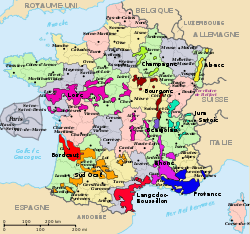
- Alsace - Alsace wine
- Bordeaux - Bordeaux wine
- Burgundy (Bourgogne) - Burgundy wine
- Champagne - Champagne
- Jura - Jura wine
- Languedoc-Roussillon
- Loire Valley - Loire Valley (wine region)
- Lorraine
- Madiran
- Provence
- Rhône - Rhône (wine region)
- Savoie
Georgia
- Abkhazia
- Kakheti, containing the micro-regions Telavi and Kvareli
- Kartli
- Imereti
- Racha-Lechkhumi and Kvemo Svaneti
Germany
- Ahr
- Baden
- Franconia (Franken)
- Hessische Bergstraße
- Mittelrhein
- Mosel
- Nahe
- Palatinate (Pfalz)
- Rheingau
- Rheinhessen
- Saale-Unstrut
- Saxony (Sachsen)
- Württemberg
Greece

- Aegean islands
- Central Greece
- Ionian Islands
- Macedonia
- Peloponnesus
Hungary
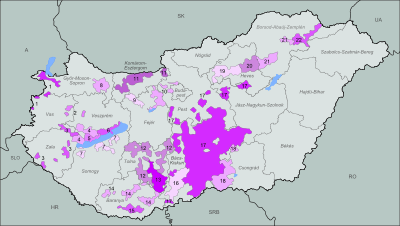
- Balaton
- Badacsony
- Balaton-felvidék
- Balatonboglár
- Balatonfüred-Csopak
- Nagy-Somló
- Zala
- Duna
- Csongrád
- Hajós-Baja
- Kunság
- Eger
- Bükk
- Eger
- Észak-Dunántúl
- Etyek-Buda
- Mátra
- Mór
- Neszmély
- Pannonhalma
- Pannon
- Pécs
- Szekszárd
- Tolna
- Villány
- Sopron
- Tokaj
Ireland
Italy
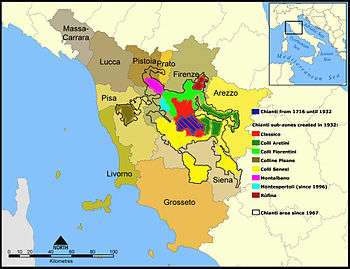
- Apulia
- Bianco di Locorotondo e Martina Franca
- Primitivo di Manduria
- Calabria
- Emilia-Romagna
- Colli Cesenate
- Sangiovese Superiore di Romagna
- Trebbiano di Romagna
- Liguria
- Lombardy
- Marche
- Castelli di Jesi
- Conero
- Piceno
- Piedmont
- Sardinia
- Sicily
- Trentino-Alto Adige
- South Tyrol, known alternatively as Südtirol (in German) or Alto Adige (in Italian)
- Trentino
- Tuscany
- Bolgheri
- Chianti
- Chianti Classico
- Colli Apuani
- Colli Etruria Centrale
- Colline Lucchesi
- Elba
- Montalcino
- Montescudaio
- Parrina
- Pitigliano
- San Gimignano
- Scansano
- Val di Chiana
- Val di Cornia
- Valdinievole
- Valle di Arbia
- Umbria
- Veneto
- Arcole
- Bagnoli
- Bardolino
- Bianco di Custoza
- Breganze
- Colli Berici
- Colli di Conegliano
- Colli Euganei
- Gambellara
- Garda
- Lessini Durello
- Lison Pramaggiore
- Lugana
- Montgello e Colli Asolani
- Piave
- Prosecco di Conegliano - Valdobbiadene
- Soave
- Valdadige
- Valpolicella
Latvia
Luxembourg
Macedonia
- Povardarie
- Skopsko vinogorje
- Tikveš
Moldova
Montenegro
Netherlands
Poland
Portugal

- Alentejo
- Bairrada
- Bucelas
- Carcavelos
- Colares
- Dão
- Lagoa
- Lagos
- Madeira
- Portimão
- Porto e Douro
- Setúbal
- Tavira
- Vinhos Verdes
Romania
Banat wine regions:
Crişana wine regions:
Dobrogea wine regions:
- Adamclisi
- Aliman
- Babadag
- Băneasa
- Cernavodă
- Chirnogeni
- Dăeni
- Hârşova
- Istria
- Măcin
- Medgidia
- Murfatlar
- Oltina
- Ostrov, Constanţa
- Ostrov, Tulcea
- Poarta Albă
- Sarica-Niculiţel
- Simioc
- Tulcea
- Valea Dacilor
- Valea Nucarilor
- Valu lui Traian
Moldavia wine regions:
- Bereşti
- Bohotin
- Coteşti
- Colinele Tutovei
- Comarna
- Copou
- Corod
- Cotnari
- Covurlui
- Cucuteni
- Dealu Morii
- Dealul Bujorului
- Hârlău
- Hlipicani
- Huşi
- Iaşi
- Iveşti
- Jariştea
- Nămoloasa
- Nicoreşti
- Odobeşti
- Panciu
- Păuneşti
- Probota
- Tănăsoaia
- Târgu Frumos
- Tecuci
- Ţifeşti
- Tomeşti
- Vaslui
- Zeletin
Muntenia wine regions:
- Seciu
- Breaza
- Cricov
- Dealu Mare
- Dealurile Buzăului
- Pietroasa
- Râmnicu Sărat
- Sercaia
- Ştefăneşti
- Tohani
- Topoloveni
- Urlaţi - Ceptura
- Valea Călugărească
- Valea Mare
- Zărneşti
- Zoreşti
Oltenia wine regions:
- Banu Mărăcine
- Calafat
- Cetate
- Corcova
- Dăbuleni
- Dealul Viilor
- Dealurile Craiovei
- Drăgăşani
- Golul Drincei
- Greaca
- Iancu Jianu
- Izvoarele
- Oreviţa
- Plaiurile Drâncei
- Pleniţa
- Podgoria Dacilor
- Podgoria Severinului
- Poiana Mare
- Potelu
- Sadova-Corabia
- Sâmbureşti
- Segarcea
- Tâmbureşti
- Vânju Mare
- Zimnicea
Transylvania wine regions:
- Aiud
- Alba Iulia
- Bistriţa
- Blaj
- Ighiu
- Jidvei
- Lechinta
- Mediaş
- Şamşud
- Sebeş-Apold
- Şimleul Silvaniei
- Târnave
- Târnăveni
- Teaca
- Triteni
- Valea Nirajului
Russia
Serbia

- Banat region
- Kosovo region[note 1]
- Nišava - South Morava region
- Pocerina region
- Srem region
- Subotica - Horgoš region
- Šumadija - Great Morava region
- Timok region
- West Morava region
Slovakia
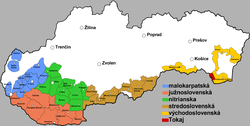
- Malokarpatská (Small Carpathians)
- Južnoslovenská (Southern Slovakia)
- Nitrianska (region of Nitra)
- Stredoslovenská (Central Slovakia)
- Tokaj (Tokaj region of Slovakia)
- Východoslovenská (Eastern Slovakia)
- The whole of southern Slovakia
Slovenia
Spain

- Andalusia
- Aragon
- Balearic Islands
- Basque Country
- Canary Islands
- Castile and León
- Castile–La Mancha
- Catalonia
- Extremadura
- Galicia
- La Rioja
- Community of Madrid
- Región de Murcia
- Navarre
- Valencian Community
Sweden
- Gutevin - Gotland
Switzerland
- Aargau [5]
- Bern [6]
- Freiburg [7]
- Geneva
- Grisons
- Neuchâtel
- St. Gallen [8]
- Schaffhausen [9]
- Thurgau [10]
- Ticino
- Valais
- Vaud
- Zürich [11]
Turkey
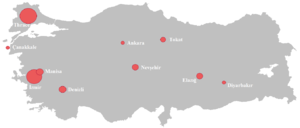
- White wine grapes:[12]
- Altıntaş – Marmara region and Bozcaada
- Beylerce – Bilecik area
- Bornova Misketi – İzmir area
- Emir – Nevşehir (Cappadocia) area
- Hasandede – Ankara and central Anatolia
- Narince – Tokat area
- Rumi, Kabarcık, Dökülgen – Southeastern Anatolia region
- Sultaniye – Aegean region
- Yapıncak – Thracian region
- Red wine grapes[12]
- Adakarası – Marmara region and Avşa Island
- Boğazkere – Elazığ and Diyarbakır areas
- Çalkarası – Çal, Denizli area
- Dimrit – central Anatolia and eastern Aegean region
- Horozkarası, Sergikarası – southeastern Anatolia region
- Kalecik Karası – Ankara area
- Karalahna – Tekirdağ region
- Karasakız – Çanakkale region
- Öküzgözü – Elazığ area
- Papazkarası – Kırklareli area
Ukraine
In Ukraine, at the present time there are seven administrative regions (provinces) in which the wine industry has developed. Given the favorable climatic location, the law of Ukraine allocated 15 wine-growing areas (macrozones), which are the basis for growing certain varieties of grapes, and 58 natural wine regions (microzones). These are located mainly in the following areas.
- Autonomous Republic of Crimea and Sevastopol - 6 macrozones with 12 microzones (69 wine grapes)
- Kherson Oblast - 2 macrozones with 10 microzones (28 wine grapes)
- Mykolaiv Oblast - 2 macrozones with 7 microzones (31 wine grapes)
- Odessa Oblast - 3 macrozones with 16 microzones (42 wine grapes)
- Zakarpattia Oblast - 1 macrozone with 12 microzones (24 wine grapes)
- Zaporizhia Oblast - 1 macrozone with 1 microzone (5 wine grapes)
United Kingdom
In the UK, area under vines is small, and whilst viticulture is not a major part of the rural economy, significant planting of new vines has been made in the early 21st century. The greatest concentration of vineyards is found in the south east of England, in the counties of Hampshire, Kent, Surrey, and Sussex.
Asia
Burma
China
Regions producing native wines have been present since the Qin Dynasty,[13] with wines being brought to China from Persia. Some of the more famous wine-producing regions are:
With the import of Western wine-making technologies, especially French technology, production of wines similar to modern French wine has begun in many parts of China with the direction of experienced French wine-makers; China is now the sixth largest producer of wine in the world. The following regions produce significant quality of wine:
- Chang'an[14]
- Dalian, Liaoning[14]
- Tonghua, Jilin[14]
- Yantai, Shandong[15]
- Yibin, Sichuan[14]
- Zhangjiakou, Hebei[14]
India
- Bangalore, Karnataka
- Bijapur, Karnataka
- Narayangaon
- Nashik, Maharashtra
- Pune, Maharashtra
- Sangli, Maharashtra
Indonesia
Indonesia has been producing wine for over 18 years, with North Bali's vineyards producing three main grape varieties, the Belgia, the Alphonse Lavallee and the Probolinggo Biru. The main producer Hatten Wines has revolutionized the world of winemaking, with eight wines produced from these three varieties.
Iran
Prior to the Iranian Islamic Revolution of 1979, Iran was a producer of wine. While production has stopped, the vineyards continue to exist and their product has been diverted to non-alcoholic purposes.
Israel
Also includes wine regions in Israeli-occupied territories.
- Bet Shemesh
- Galilee
- Golan Heights
- Jerusalem
- Judean Hills
- Latrun
- Mount Carmel
- Rishon LeZion (wine production since 1886)
Japan
Kazakhstan
Republic of Korea
- Anseong, Gyeonggi-do[16]
- Gimcheon, Gyeongsangbuk-do
- Gyeongsan, Gyeongsangbuk-do
- Yeongcheon, Gyeongsangbuk-do
- Yeongdong, Chungcheongbuk-do[17]
Lebanon
Palestinian territories
Syria
Vietnam
Oceania
Australia
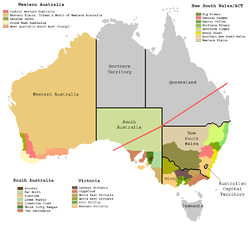
Geographic indications for Australian wine are governed by law. The geographic indication must indicate where the grapes are grown, irrespective of where the wine itself is made. A geographic indication may be "Australia", "South Eastern Australia", a state name, zone, region or subregion if defined.[18]
The zones, regions and subregions in each state are listed below:
New South Wales
- Big Rivers
- Central Ranges
- Hunter Valley
- Hunter
- Broke Fordwich
- Pokolbin
- Upper Hunter Valley
- Hunter
- Northern Rivers
- Northern Slopes
- South Coast
- Southern New South Wales
- Canberra District (includes the northern part of the Australian Capital Territory)
- Gundagai
- Hilltops
- Tumbarumba
Queensland
- Regions, no zones defined
South Australia
Adelaide Super Zone includes Mount Lofty Ranges, Fleurieu and Barossa wine zones.
Tasmania
- Regions, no zones defined
- Coal River
- Derwent Valley
- East Coast
- North West
- Pipers River
- Southern
- Tamar Valley
Victoria
- Central Victoria
- Bendigo
- Goulburn Valley
- Heathcote
- Strathbogie Ranges
- Upper Goulburn
- Gippsland
- North East Victoria
- North West Victoria
- Port Phillip
- Western Victoria
Western Australia
- Greater Perth
- South Western Australia
New Zealand
- Auckland Region
- Bay of Plenty
- Canterbury
- Central Otago
- Hawke's Bay region
- Gimblett Gravells
- Gisborne
- Marlborough
- Nelson
- Northland Region
- Waikato
- Wairarapa
Notes
- ↑ Kosovo is the subject of a territorial dispute between the Republic of Kosovo and the Republic of Serbia. The Republic of Kosovo unilaterally declared independence on 17 February 2008, but Serbia continues to claim it as part of its own sovereign territory. The two governments began to normalise relations in 2013, as part of the Brussels Agreement. Kosovo has received recognition as an independent state from 110 out of 193 United Nations member states.
References
- 1 2 3 4 5 "The History of Vineyards in Algeria". Atlasian Cellars Meghdir & Sons. 2005. Retrieved 2005-04-07.
- ↑ virginiawines.org
- ↑ Niagara Escarpment
- ↑ http://www.czechtourism.com/a/prague-vineyards/
- ↑ http://www.ernestopauli.ch/Wein/Schweiz/SchweizAargau.htm
- ↑ http://www.ernestopauli.ch/wein/schweiz/SchweizBern.htm
- ↑ http://www.ernestopauli.ch/Wein/Schweiz/SchweizFreiburg.htm
- ↑ http://www.ernestopauli.ch/Wein/Schweiz/SchweizStGallen.htm
- ↑ http://www.ernestopauli.ch/wein/schweiz/SchweizSchaffhausen.htm
- ↑ http://www.ernestopauli.ch/Wein/Schweiz/SchweizThurgau.htm
- ↑ http://www.ernestopauli.ch/Wein/Schweiz/SchweizZ%C3%BCrich.htm
- 1 2 "Grapes grown for wine production in Turkey". Yazgan Winery. 2007. Retrieved 2007-06-06.
- ↑ http://www.fask.uni-mainz.de/inst/chinesisch/wineculture_abstract_chenxigang.pdf
- 1 2 3 4 5 Chinese Markets for Wines :wines-info
- ↑ http://www.wines-info.com/Newshtml/200812/2282008123011241759.html
- ↑ Anseong Culture Tour City of Anseong
- ↑ Official Site of Korea Tourism Org.: Wine Korea Official Site of Korea Tourism Organization
- ↑ "Register of Protected Names Section (a) Australian GI". Australian Wine and Brandy Corporation. Retrieved 2008-04-08.
- ↑ "Western Australia's Wine Regions". Western Australia. Retrieved 2010-11-25.